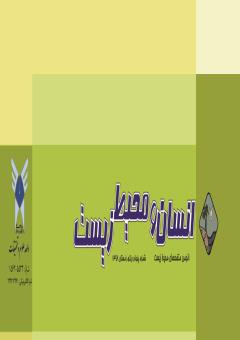بررسی زیستمحیطی پارک¬های ملی ایران و ارائه یک الگوی متناسب برای مدیریت آنها (موردی: پارک ملی گلستان)
محورهای موضوعی : ارزیابی پی آمدهای محیط زیستیمحمد علی جعفری 1 * , بتول غفاری خواه 2 , معصومه خلفی 3 , غلامرضا فریفته جهان تیغ 4
1 - دانشجوی دکتری- علوم و مهندسی محیط زیست، دانشکده منابع طبیعی، دانشکده کشاورزی و منابع طبیعی، دانشگاه تهران، کرج. *(مسوول مکاتبات)
2 - کارشناسی ارشد،گروه تنوع زیستی و مدیریت اکوسیستم ها، پژوهشکده علوم محیطی، دانشگاه شهید بهشتی- تهران.
3 - کارشناس ارشد-ارزیابی و آمایش سرزمین - دانشگاه آزاد واحد تاکستان.
4 - کارشناس ارشد-ارزیابی و آمایش سرزمین - دانشگاه آزاد واحد تاکستان.
کلید واژه: محیط زیستی, پارک ملی گلستان, SWOT, مدیریت, توسعه پایدار.,
چکیده مقاله :
زمینه و هدف: تخریب و انهدام مناطق تحت مدیریت سازمان حفاظت محیطزیست بهویژه پارکهای ملی میبایست از جنبههای گوناگون موردبررسی قرار گیرد؛ بنابراین این مقاله از دیدگاه .قوانین زیستمحیطی به بررسی موضوع یادشده پرداخته است.
روش بررسی: ارزیابی اقدامات مخرب و پاسخهای قانونی مربوط، که در قوانین و مقررات ایران پیشبینیشده است، همراه با چگونگی اثربخش بودن یا نبودن آنها در راستای جلوگیری از وقوع جرائم زیستمحیطی مربوط به تخریب پارکهای ملی از مواردی است که در این تحقیق مطرح میگردد. به این منظور مقاله حاضر با بهرهگیری از مطالعات میدانی، تعیین نقاط قوت، ضعف، فرصتها و تهدیدها به شیوه SWOT به ارائه استراتژیها و راهکارهایی در جهت مدیریت و توسعه پایدار در پارک ملی گلستان پرداخته است.
یافته ها: پارک ملی تنها در صورت داشتن یک مدیریت مطلوب و کار آمد میتواند ارزشهای اکولوژیکی، فرهنگی و معنوی خود را حفظ نماید. یک مدیر خوب نیز در صورتی میتواند به مدیریتی بهینه برای اداره پارکهای ملی دست یابد که علاوه برداشتن ابزارهای اجرایی لازم یک چارچوب قانونی متناسب برای حفظ و نگهداری آن نیز وجود داشته باشد. بدیهی است برای رسیدن به نتایج یادشده، شناخت پارکهای ملی ازلحاظ زیستمحیطی و چگونگی پیدایش آنها ضروری خواهد بود؛
بحث و نتیجه گیری: نتایج بهدستآمده از این پژوهش نشان میدهد منطقه مذکور دارای قابلیتهای بسیار فراوان در زمینۀ زیستمحیطی است که نیازمند توجه و برنامهریزی مناسب در این مناطق میباشد. درهرحال برای ارتقاء مدیریت بهینه و حفظ و نگهداری پارکهای ملی ایجاد قوانین کارآمد همگام با قوانین جهانی و اجرای آن توسط مسئولین و آشنایی مردم باارزشهای پارک ملی ضروری به نظر میرسد.
Background and Objective Destruction of areas under the management of the Environmental Protection Agency, especially national parks, should be considered from various aspects; Therefore, this article examines this issue from the perspective of environmental laws.
Material and Methodology: Assessing the destructive actions and related legal responses, which are provided in the laws and regulations of Iran, along with how they are effective or not in order to prevent environmental crimes related to the destruction of national parks is one of the issues raised in this study. For this purpose, the present article, using field studies, identifying strengths, weaknesses, opportunities and threats by SWOT method, has presented strategies and solutions for sustainable management and development in Golestan National Park.
Findings: The national park can preserve its ecological, cultural and spiritual values only if it has a good and efficient management. A good manager can also achieve optimal management for the management of national parks if, in addition to removing the necessary executive tools, there is an appropriate legal framework for its maintenance. Obviously, in order to achieve the mentioned results, it will be necessary to know the national parks from the environmental point of view and how they came into being;
Discussion and Conclusion: The results obtained from this study show that the region has many capabilities in the field of environment that requires proper attention and planning in these areas. In any case, in order to promote the optimal management and maintenance of national parks, it seems necessary to create efficient laws in line with international laws and to implement them by the authorities and to acquaint the valuable people of the national park.
1. Holden, A.Environmental and Tourism New York, Routledge, 225. 2000.
2. Dudley N, Stolton S. Defining protected areas: an international conference in Almeria, Spain. IUCN, Gland. 2008.
3. Weaver D, Oppermann M. Tourism management. John Wiley and Sons; 2000.
4. Rowman & Littlefield. The Critical Documents america's National Park. 1997.
5. Florian Schulz, The Mountaineers BooksYellowstone to Yukon. 2008.
6. https://doe.ir/Portal/Home/default.aspx
7. Ghashtasb, H. Golestan National Park. Joint publication by the Department of Environment. ISBN: 946-6065-22-8. 2003. (In Persian)
8. Hom Haacke L. Using SWOT for project planning sessions, PN. 3 hughes. A. Tourism as Sustainable Industry in the Rural Community of Arising, West Scotland (Doctoral dissertation, M. Sc Thesis, Napier University). 2001.
9. Nouri, J., Abbaspour, M., & Maghsoudlou Kamali, B. Environmental Assessment of Strategic Industrial Development Policies in Iran Using the SWOT Model. Journal of Environmental Science and Technology, 29(2). 2006. (In Persian)
10. National Parks and Wildlife Regulation 2019under the National Parks and Wildlife Act 1974. public consultation draft. s2018-481.d05 8 May 2019.
11. David, F. R. Strategic Management. Translated by Ali Parsaeian and Seyyed Mohammad Aarabi. Sixth Edition. 2004. (In Persian)
12. Harrison, J., & Caron, J. Strategic Management. Translated by Behrooz Ghasemi. First Edition. Heyat Publications, Tehran. 2003. (In Persian)
13. Detailed Plan for Golestan National Park, 2007. (In Persian)
14. Dehdar Dargahi, M., & Makhdoom, M. Zoning of Golestan National Park. Journal of Environmental Science, 28(29), No. 499. 2002. (In Persian)

